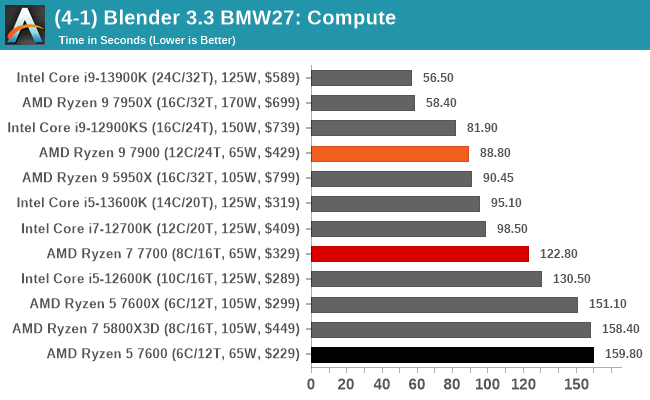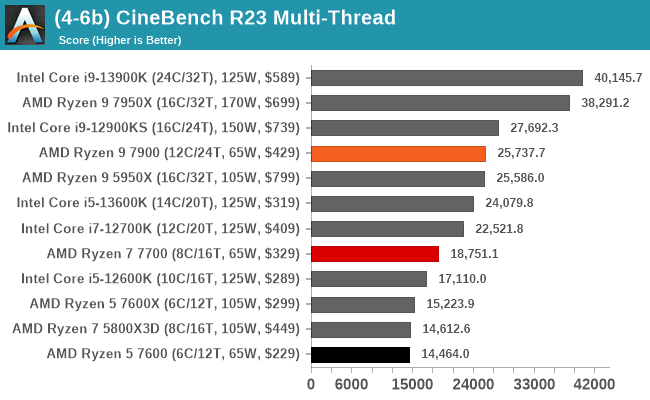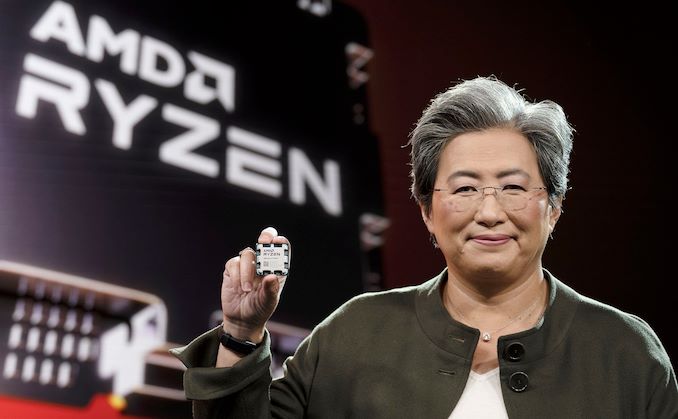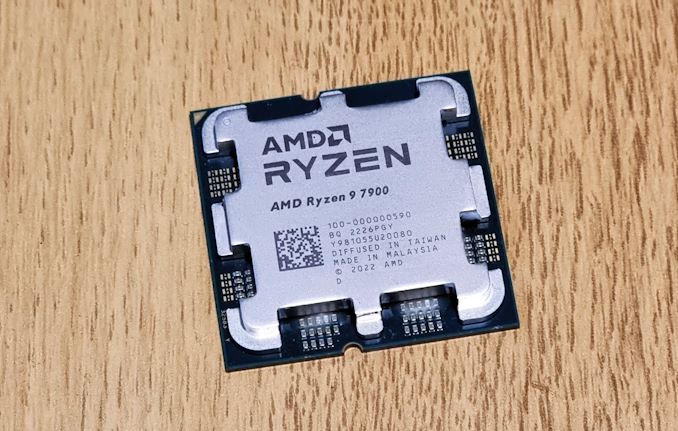The AMD Ryzen 9 7900, Ryzen 7 7700, and Ryzen 5 7600 Review: Zen 4 Efficiency at 65 Watts
by Gavin Bonshor on January 9, 2023 9:00 AM ESTConclusion
Ever since we reviewed the Ryzen 9 7950X and Ryzen 5 7600X processors back in September, it was clear that AMD had a solid architecture on their hands with Zen 4, as it showed double-digit improvements to performance over the Ryzen 5000 (Zen 3) series. Although the Ryzen 9 7950X showed inherently higher levels of power consumption and core temperatures in comparison to the Ryzen 9 5950X, AMD's design choice by opting to boost cores up to high frequencies such as 5.7 GHz is one that was worth implementing to maximize outright performance. But that doesn't mean Zen 4 is a one-trick pony.
With the Ryzen 7000 65 W family, AMD is looking to change the dynamic that users need to consume oodles of power to achieve high levels of performance. To do that, they're launching three SKUs, including the Ryzen 9 7900 (12C/24T), Ryzen 7 7700 (8C/16), and Ryzen 5 7600 (6C/12T).
Along similar lines, we recently looked at how the AMD Ryzen 9 7950X and Intel Core i9-13900K scale when adjusting the Power Package Tracking (PPT) and Thermal Design Power (TDP) to lower levels, to see how much limiting power to the cores has on overall performance. When it comes to AMD, the overall consensus of our CPU power scaling results showed that AMD's Zen 4 core architecture is very efficient, even at lower power levels. So it's easy to see why AMD has released 65 W SKUs based on its ability to deliver leading performance-per-watt efficiency than it ever has previously. That was, of course, with the Ryzen 9 7950X, which is a 16-core and 32-thread part, but does all of that efficiency translate when shaving off some of those cores and threads?
Ryzen 7000 at 65 W: Performance Analysis
Diving into how the Ryzen 9 7900 ($429), Ryzen 7 7700 ($329), and the Ryzen 5 7600 ($229) performed in our updated CPU suite, we were pretty impressed with the overall performance on offer, despite being limited to a 65 TDP limit. Although power consumption on the CPU package was around 90 W at full load, this is still considerably lower than other processors the trio of 65 W Ryzen 7000 chips was pitted against.

Taking one of our results in Blender 3.3 as an example (BMW27), we can see that the AMD Ryzen 7900 performs better than the Ryzen 9 5950X, even at 65 W. This is superb performance-per-watt efficiency compared to the previous generation, especially given it's 12C/24T at 65 W versus 16C/32T Zen 3 at 105/140W. In the case of the Ryzen 7 7700, it still performed well and sat between the Intel Alder Lake 12th Gen Core i5-12600K and Core i7-12700K; despite conceding power, cores, and threads all around.
Looking at the entry-level six-core part, the Ryzen 5 7600, the lack of cores, threads, and power, the combination of the three did take the legs away from it a little bit, especially in heavy multi-threaded workloads.

While single-threaded performance isn't much of a concern due to the superior levels of IPC performance with AMD's 5nm-fabbed Zen 4 core, multi-threaded performance isn't as detrimental to the Ryzen 5 7600 as going from 105 W to 65 W may seem. In CineBench R23's multi-threaded test, the Ryzen 5 7600 at 65 W and the Ryzen 5 7600X (105 W) are rather comparable in overall performance. There's a minor performance hit, but not enough to make it black and white.
Looking at the Ryzen 9 7900, it marginally beats out the Ryzen 9 5950X and sits just below the Intel Core i9-12900KS, a power-hungry yet very rapid top-of-the-range desktop processor from last year. The Ryzen 7 7700 again sits between the Core i7 and Core i5 K-series Alder Lake (12th Gen) processors.

Turning our attention to gaming performance, all three AMD Ryzen 7000 65 W SKUs perform well at 1080, 1440p, and 4K resolutions. Of course, the key to this performance is using a top-tier graphics card such as the Radeon RX 6950 XT, but the performance is still notably good. All three AMD models perform consistently well in Borderlands 3 at 1080p maximum settings despite being limited to 65 W TDPs.
This tells us that the CPU performance from Zen 4 at 65 W, even with fewer cores than other chips on test, is powerful enough for AAA titles when paired with a high-performing graphics card. Of course, users on a budget may want to pair up a Ryzen 5 7600 with a card such as an AMD Radeon RTX 6600, and it's going to be a different proposition to what we're testing with, but we test with an RX 6960 XT for parity in our results.
Closing Thoughts: Ryzen 7000 at 65 W is Highly Efficient
For a budget gaming PC, the Ryzen 5 7600 ($229) is an interesting proposition when paired up with a B650 motherboard and an affordable pair of DDR5 memory sticks, such as Corsair's Vengeance 32 GB (2 x 16 GB) kit. Intel also has its own 13th Gen Core 65 W series processors coming to the market, with similar pricing on a core-to-thread count basis with AMDs. The advantage of AMD's Ryzen 7000 65 W SKUs is that they are unlocked, so users can overclock them and squeeze out additional performance. The disadvantage is that the Ryzen 7000 series is only compatible with DDR5 memory. In contrast, Raptor Lake supports DDR5 and DDR4, which must be factored in for users on a stringent budget.

AMD CEO Dr. Lisa Su presented the Ryzen 7000 series back in September 2022
From a performance perspective, the Ryzen 9 7900 and Ryzen 7 7700 are shooting it out with processors with more expensive MSRPs, which also adds to the value proposition. In terms of power efficiency, all of the Ryzen 7000 65 W SKUs shows incredible performance, despite being power limited and running at 100 W under maximum load, at least from our experience in testing them.
If video editing, content creation, and rendering are desired, and performance is critical, the Ryzen 9 7950X is the go-to chip if AM5 is essential, but the Ryzen 9 7900 competes in gaming. It's cheaper while still offering solid performance in compute-heavy workloads. The Ryzen 9 7900 loses out in raw compute power against the flagship bearing Ryzen 9 7950X, but the Ryzen 9 7900 uses much less energy to achieve what we think is a solid level of performance.
Another avenue offering additional value to users is AMD has bundled coolers with each of the three Ryzen 7000 65 W CPUs. Included with the Ryzen 9 7900 and Ryzen 7 7700 is AMD's Wrath Prism cooler with RGB LED lighting that can be customized via AMD's Wraith Prism LED software. The entry-level Ryzen 5 7600 is an AMD Wraith Stealth cooler, which is smaller by design and practical to keep the CPU cool under load, but without the pizazz of RGB. Bundling coolers with its more affordable CPUs means users can spend their budget on a premium AIO cooler through better memory, storage, or graphics, which will have a positive impact on performance.
Overall, AMD and the Ryzen 9 7900 ($429), Ryzen 7 7700 ($329), and Ryzen 5 7600 ($229) all represent different propositions to users looking for a solid low-powered desktop processor to build a system with. They also represent different levels within the market, including the entry-level with the Ryzen 5 7600, the mid-range with the Ryzen 7 7700, and the middle to high-end of the market with the Ryzen 9 7900. All three produce the goods, even at 65 W in terms of performance-per-watt efficiency, and it's good to see that AMD doesn't just kick it at the higher-end (Ryzen 9 7950X); it also proves Zen 4 can deliver the goods in power-limited situations too.
The levels of efficiency with Zen 4 at 65 W are awe-inspiring, but the next step on the Zen 4 train is Ryzen 7000 X3D, which is due sometime in February. How its 3D L3 V-Cache laden chips deliver is an entirely different proposition, but one we look forward to seeing pan out in real-time.











55 Comments
View All Comments
bcortens - Monday, January 9, 2023 - link
Does sustained power consumption look similar to peak power consumption?Why does your article lead with "Efficiency at 65 Watts" when the peak power is 90 Watts?
AshlayW - Monday, January 9, 2023 - link
Because the Platform Power Target (PPT) for '65W TDP' models from AMD has always been around 87W (~90 give or take). The TDP is thermal watts for cooling systems not sustained electrical watts for power usage. I assume the author is implying that the models are the AMD-rated 65W TDP and are efficient, not that they specifically use 65 watts, but I suppose it's kinda misleading.meacupla - Monday, January 9, 2023 - link
yeah, not all the electrical energy going into the chip ends up as heat energy.saratoga4 - Monday, January 9, 2023 - link
All of the electrical energy going into the chip does become heat aside from a tiny bit that leaves as bits on the various buses (which is mostly canceled out by energy coming in from other chips on the same bus). The difference between TDP and peak power is that the CPU can thermally throttle if needed.ballsystemlord - Monday, January 9, 2023 - link
A CPU is not a resistor. So not all the energy is converted into heat.For example, some of it goes down the PCIe bus, and heats up the PCB traces and PCIe card. Likewise with the RAM.
Samus - Wednesday, January 11, 2023 - link
Intel and AMD have dramatically different packaging. The TDP designation in AMD CPU's applies to the CPU portion of the package ie ZEN core chiplet(s) while the IO CCD is rolled into the PPT as it is effectively the rest of the "platform."If we were to try comparing fruits, AMD's PPT would be comparable to Intel's TDP + chipset (Z690 is 6-watts) + other external components that would otherwise be integrated in a Ryzen IO but as these architectures are vastly different a direct comparison is impossible; for example, AMD's IO is far more complex than Intel's, supporting a wider range of platform designs and IO types. While Intel and AMD both support DDR4\5 at this point within their memory controllers, PCIe 3.x\4.x\5.x is handled inside of AMD's IO while Intel offloads much of that to the chipset, only supporting some lanes inside the CPU, and many CPU's not supporting 5.x. To make matters worse, the Z690 is manufactured on a 14nm process while AMD's IO CCD is 7nm (or something like that) so while the Z690 would use much more power if it did the same thing as the AMD IO CCD, it doesn't. In fact it does very little and the package itself is tiny like 25mm2. This means the AMD IO handles a lot more while being 7nm while Intel integrates all of that into the CPU die which is a more refined 10nm process that efficiency is somewhere between TSMC 5nm and 7nm.
Basically AMD's CPU CCD (5nm?) is more efficient while their IO (7nm?) is less efficient and this doesn't entirely balance out compared to Intel's monolithic 10nm (which more efficient than TSMC's 7nm.)
This chart breaks it down better than I can - scroll down to density comparison: https://www.granitefirm.com/blog/us/2021/12/28/tsm...
ballsystemlord - Thursday, January 12, 2023 - link
It's unclear to me how this relates to my post.I was saying that not all the power is turned into heat, therefore, the 90w figure is not misleading.
ballsystemlord - Monday, January 9, 2023 - link
Also worth noting is that the power dissipated is related to the resistance of the component, not the amount of power going into the component. You should recall that from any basic series circuit you have worked with/on.escksu - Tuesday, January 10, 2023 - link
It's true that it's related to resistance but in the case of the cpu, it's mostly due to the rapid switching of transistors.escksu - Tuesday, January 10, 2023 - link
Not all but most of becomes heat. It's due to the rapid switching on/off of the transistors.